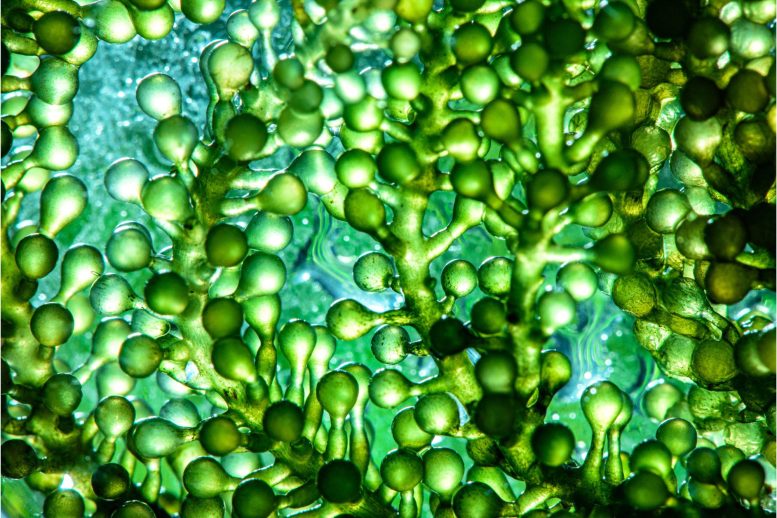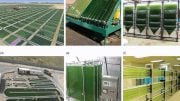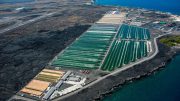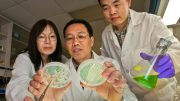
Microalgae are microscopic aquatic organisms that have gained attention as a potential source of food. They are highly nutritious and contain a rich source of essential fatty acids, vitamins, and minerals.
Scientists have highlighted the ecological and nutritional benefits of aquatic plants, along with the technical and financial difficulties in expanding production.
Algae. It’s what’s for dinner.
This spin on a famous U.S. advertising tagline from the beef industry may appear amusing, it’s no joke that the existing agricultural system is a significant contributor to greenhouse gas emissions and ecological degradation. These issues, in turn, pose a significant threat to food security for billions of people globally due to the adverse effects of climate change and ecosystem destruction.
Scientists at the University of California, San Diego (UCSD) believe that algae could be a new type of superfood, thanks to its high protein and nutrient content. They present their arguments in a recently published paper in the journal Frontiers in Nutrition, which reviews the current body of scientific knowledge on microalgae – a general term for the thousands of tiny algal species and other photosynthetic organisms, such as cyanobacteria, found in aquatic environments.
A more efficient food source
The review highlights the current technologies for commercially developing and growing microalgae, as well as the scientific and economic challenges to scaling production. While long studied as a source of biofuel thanks to their high lipid or fat content, algae are also attracting interest from researchers because of their potential to be a more efficient food source.
“Many of us have known the potential of algae for food for years, and have been working on it as a food source, but now, with climate change, deforestation, and a population of eight billion people, most everyone realizes that the world simply has to become more efficient in protein production,” said co-author Dr. Stephen Mayfield, a professor of biology at UCSD and director of the California Center for Algae Biotechnology.
For instance, a 2014 study cited in the current paper by Mayfield and his team found that algae can produce 167 times more useful biomass than corn annually while using the same amount of land. Other models predict that existing algae strains could potentially replace 25% of European protein consumption and 50% of the total vegetable oil consumption when grown on available land that is not currently used for traditional crops.
“The biggest advantage is the protein production per acre,” Mayfield noted. “Algae simply dwarf the current gold standard of soybean by at least 10 times, maybe 20 times, more production per acre.”
In addition, some algal species can be grown in brackish or salty water – and, in at least one case, wastewater from a dairy operation – meaning freshwater can be reserved for other needs. Nutritionally, many algal species are rich in vitamins, minerals, and especially macronutrients essential to the human diet, such as amino acids and omega-3 fatty acids.
Creating the best algal strain for humans
Challenges still remain, starting with finding or developing algal strains that check all of the boxes: high biomass yields, high protein content, full nutrition profile, and the most efficient growing conditions in terms of land use, water requirements, and nutrient inputs.
In the paper, the UCSD authors describe the various scientific tools available to produce the most desirable traits for a commercially viable algal product. For example, one previously published experiment described enhancing astaxanthin, an antioxidant pigment that has been shown to have various health benefits, through targeted genetic mutations. Another mutagenic experiment was able to increase both biomass yield and protein content for a different algal strain, particularly when grown in a simple, low-cost sweet sorghum juice.
Mayfield said the most likely approaches for the commercial development of a superior algal crop would involve a combination of traditional breeding with molecular engineering. “This is the way modern crops are being developed, so this is the way algae will be developed,” he said. “They are both plants – one terrestrial and one aquatic.”
Nutrition and yield aren’t the only considerations. Some tweaking of color, taste, and decreasing that characteristic fishy smell may be needed to convert some consumers. Other experiments have already demonstrated the ability to modify these organoleptic traits while boosting protein content in new strains of algae.
The need to feed a growing population
Indeed, the biggest challenge for commercial development, Mayfield added, isn’t necessarily scientific, technical, or aesthetic. It’s the ability to scale production globally.
“You just can’t know all the challenges of going to world scale, until you do,” he said, “But the world has done this [with] smartphones, computers, photovoltaic panels, and electric cars – all of these had challenges, and we overcame them to take these ‘new’ technologies to world scale, so we know we can do it with algae.”
Mayfield said the need for alternative food systems has never been more urgent, as the human population swells, pushing resources and systems to the breaking point. “The only way to avoid a really bleak future is to start transitioning now to a much more sustainable future, and algae as food is one of those transitions that we need to make,” he said.
Reference: “Developing algae as a sustainable food source” by Crisandra J. Diaz, Kai J. Douglas, Kalisa Kang, Ashlynn L. Kolarik, Rodeon Malinovski, Yasin Torres-Tiji, João V. Molino, Amr Badary and Stephen P. Mayfield, 19 January 2023, Frontiers in Nutrition.
DOI: 10.3389/fnut.2022.1029841
The study was funded by the US Department of Energy.









While it is relatively easy to pick a desired macroscopic plant (food) from other macroscopic plants (weeds, some of which are poisonous) it is much more difficult to do that with microscopic plants (takes a lot of microscope time sorting them out). Contamination with other algae from the air needed to supply CO2 is going to be a significant problem with large scale production. Growing algae on a large scale is probably a lot easer than growing ONLY the algae you want on a large scale. Macroscopic plant farmers spend billions on that problem and the chemicals used cause all sorts of problems “down stream”.
Greetings~ Very helpful advice on this article! It is the little changes that make the biggest changes. Thanks a lot for sharing!
The site is of high quality. Great content here.